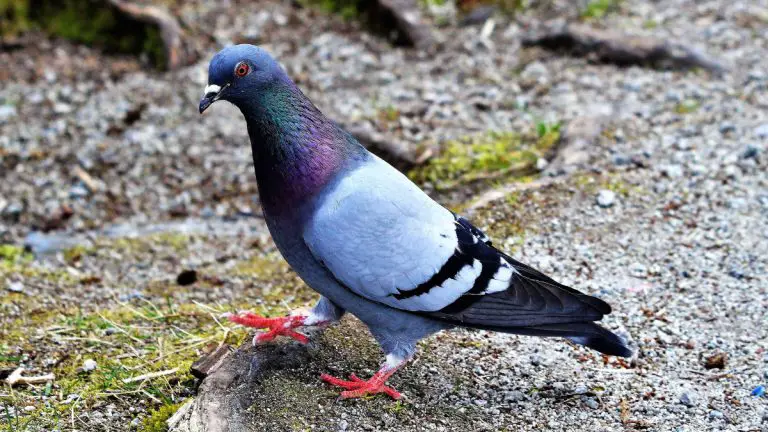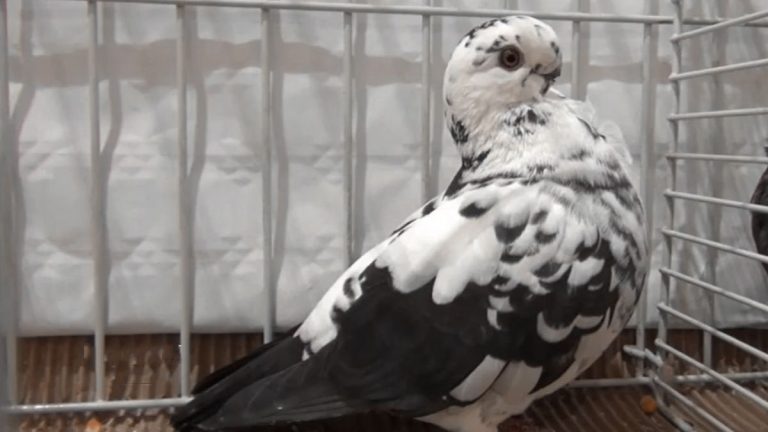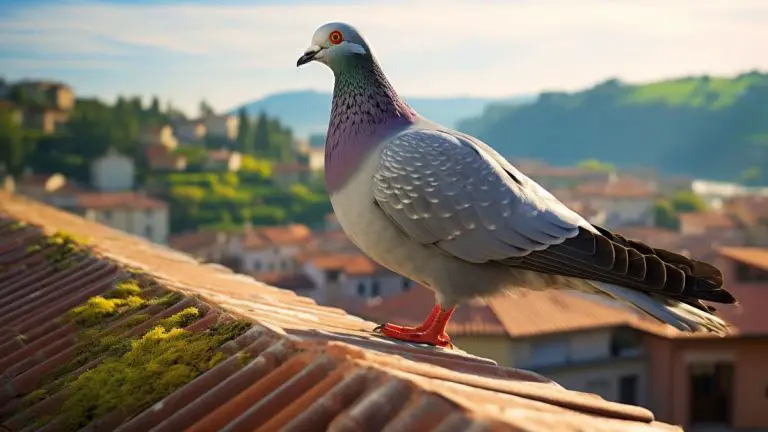Victoria Crown Pigeon: Origin, Appearance, Behavior, Care, And More
Many breeds of pigeons across the wild will pale in comparison to the Victoria Crowned Pigeon. The crest sitting beautifully on its head plus its sheer size makes it one of the most—if not the most—beautiful pigeon on the planet!
It’s no wonder the pigeon was named in the honor of Queen Victoria, the British monarch of the 19th century.
But that’s not where the wonders of this bird end.
In this article, we dig deeper into the origins and history of this bird, a detailed physical description, its behavior, temperament, and how long Victoria crowned pigeons live. We’ll also touch on whether you can keep this beauty of a bird as a pet and tips for proper care to keep it in good health and shape.
Victoria Crown Pigeon Quick Facts:
| Scientific name | Goura victoria |
| Breed name | Victoria Crown Pigeon |
| Other names | Blue Crowned Pigeon, Victoria Crowned Pigeon |
| Origin | New Guinea |
| Size | Large (up to 75cm long) |
| Weight | 5.5 to 7 pounds |
| Flying ability | Can do short, powerful flights |
| Cost | $2000+ per bird |
| Lifespan | Around 25 years |
Origin and history
Victoria crown pigeon is native to New Guinea in West Africa. From this region, the bird was introduced to nearby islands, including Indonesia. Today, the bird is common in various US zoos and aviaries, though it’s a rare bird in pet trades.
It belongs to the genus Goura which encompasses 4 unique and large-sized ground-dwelling pigeon breeds that are native to New Guinea. This includes the extinct ground-dwelling pigeon known as the dodo.

The bird got its name in the honor of Queen Victoria. This is due to its beautiful blue crown comprised of lacey, crested head feathers, in addition to a regal poise.
According to the IUCN red list, the Victoria crown pigeon is labeled as a near-threatened species. The body notes that currently, the population of Victoria crown pigeons stands at around 10,000 to 20,000 birds.
So, why is the Victoria crowned pigeon endangered? Their numbers in the wild are decreasing as they’re usually hunted for their meat as well as their feathers in the tropical rainforests of their native region, New Guinea.
Deforestation also leads to the destruction of their natural habitat, further affecting the bird’s survivability.
Appearance
The Victoria crown pigeon strikes your eyes as a large pigeon with bluish-grey body plumage, maroon breasts, red eyes, and an elegant lace-like crest.
An adult Victoria crowned pigeon size is. in simpler words, these birds are the largest of the pigeon and dove families. A mature bird is as big as an adult turkey hen!
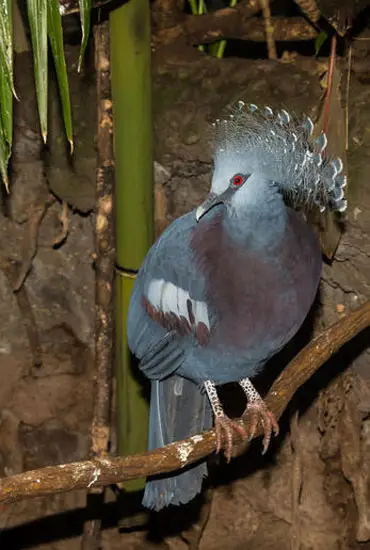
The crest itself features white tips which make the bird easily recognizable from others members of its genus Goura.
Still on the physical appearance, you may also want to know what’s the divergence in Victoria crowned pigeon male vs female.
The two sexes are initial in appearance, though males are usually larger than females. Males are also known to sing the most compared to females.
It can be challenging even for experienced breeders to tell the two birds apart.
Behavior
Victoria crown pigeons are social birds. In the wild, they’re often observed traveling in pairs or even small groups as they search for food.
In captivity, they also show gentle and docile nature and easily get along well with other species of birds. However, we advise keeping them alone due to their large sizes.
As ground-dwelling pigeons, these birds usually spend the better of their time on the ground. They’ll only fly up to the trees at night to roost or when disturbed during the day.
So if you’re wondering, Can a Victoria crown pigeon fly?
Yes, this pigeon can fly short distances. But it only flies so when necessary, e.g. when it feels threatened, startled, or at night to roost.
The birds are also easily tamable and can become quite trusting of their owners after they become acclimated to their new homes.
Males are known to exhibit aggressive signs as a way of establishing dominance. They usually puff up their chests and then raise their wings as if they’re preparing to attack an enemy. (Source).
Males also tend to become aggressive towards other males during the breeding period, so you should ensure you pair them in separate nesting sites to prevent fights.
The birds employ a variety of calls to communicate with each other. However, the bird’s vocalization is not the soft cooing you hear from other pigeons.
Instead, the bird tends to let a hollow boom sound that’s usually loud and surprising.
Listen to the bird make this unique sound in the video below.
Video:
Diet
Victoria crown pigeons in the wild like feeding on fallen seeds, fruits, berries, and occasionally small insects. The diet isn’t much different for birds in captivity. You should feed them high-quality seeds and grain mix.
Additionally, you should provide them with fresh vegetables and fruits occasionally. And make sure you provide them with clean and fresh water to keep them hydrated.
Victoria Crown Pigeon as pets
Victoria crown pigeon is suitable for keeping as a pet. But you must be able to meet its special care requirements as discussed below.
Firstly, you should get a pair of these birds and not only one to keep them from becoming lonely.
You’ll need to provide the birds with spacious and clean housing. Remember, these pigeons are ground dwellers, so they’ll require a lot of floor space to walk over and explore.
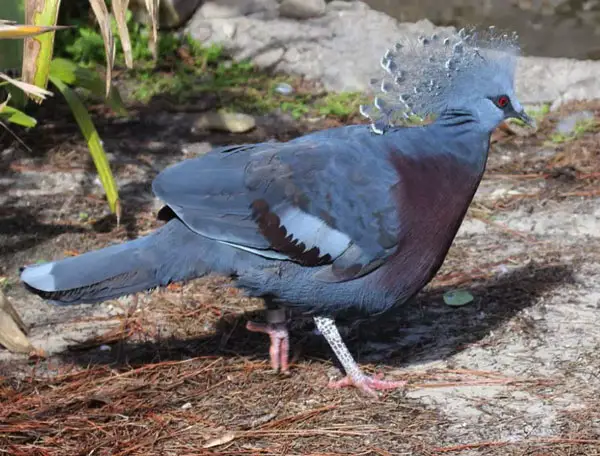
The birds are also quite large, further stressing the need for a spacious aviary for them. We advise providing them with a minimum of 20 feet long x 10 feet wide x 8 feet tall for a pair.
Because these birds are ground foragers, you’ll need to clean their housing regularly. This will help keep them from developing health issues as a result of eating the droppings alongside their food on the floor.
You should also keep the housing free from harsh weather conditions. These birds are from a tropical climate, meaning they’ll do well in warm, humid conditions.
If you live in regions where it gets extremely cold, below 40 degrees F, you’d want to plan how to keep the birds warm. Additionally, you should protect the birds from rain and windy weather.
These birds are also friendly to other birds. But it’d be a good idea if you mix them up with species where the pigeon is the only ground forager.
This will help keep them from getting stressed as they prefer a calm environment.
Above all, you should provide the birds with proper nutrition to keep them healthy. Note that these birds can suffer from various health issues such as respiratory infection, so you should have an avian vet regularly check them to keep them healthy.
Breeding
The Victoria crown pigeons are also good breeders. It’s interesting to know that these birds are monogamous, so once a pair starts mating, they’ll continue mating for life.
After mating, the female lays one large egg the size of a chicken which then hatches after about around 28 to 30 days of incubation. The incubation responsibility is shared by both parents.

The Victoria crowned pigeon baby then stays in the nest and is cared for by its parents for an additional 30 days.
And even after the pigeon leaves the nest, it is still under the care of its parents for an additional 30 days. This makes the total care period roughly 90 days or 3 months.
The Victoria crown pigeons are also reliable parents and will closely rear and feed their young ones until they reach an age where they can feed on their own.
Similar to most breeds of pigeons, this bird produces the ‘crop milk’ that it feeds to its chicks during their first days. Note that this special milk is produced by both parents.
Price
The cost of a Victoria crowned pigeon is usually high compared to that of other pigeons.
A typical bird goes for about $2000 to $2500, though the price can be even higher depending on the breeder you buy from and your location.
However, most breeders in the US will sell you this bird at around this price. If you’re far away from the breeder, then you should add the shipping cost.
That said, you should take your time to get a reputable breeder to ensure you get a healthy bird.
If you get your bird from a rescue center or adoption organization, check that it’s healthy—active, alert, with clear eyes, full crop, and clean feathers are all signs of a healthy bird.
Lifespan
The Victoria crown pigeon can live for up to 25 years in captivity with good care. Refer to our section about pigeons as pets for more details on how to take proper care of your pigeon to maximize its lifespan.
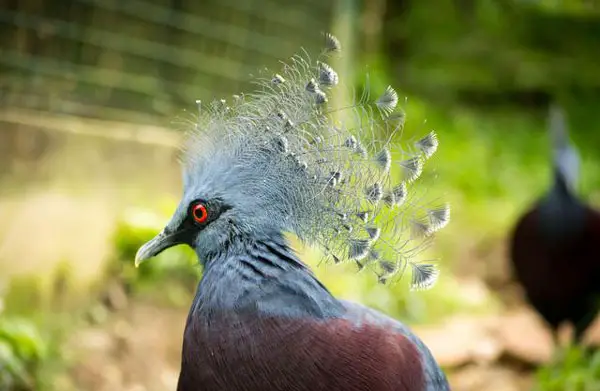
Final Verdict
The magnificent Victoria crown pigeons are among the most beautiful pigeons that were even named in the honor of Queen Victoria, the British monarch. The interesting features that make these birds stand out include their extra-large size and attractive crown that sits on their head.
If you want to keep this pigeon as a pet, then you’ll need to meet its special care requirements including housing it in a super-spacious enclosure due to its size. With proper care and attention, this bird can live for as many as 25 years in captivity.



